Jun 27, 2023
Why do we have ethical dilemmas? The ethical design practice borns from self-awareness of ethical dilemmas. It starts by critically questioning ‘why’ to what you create for.
“Technology is the answer, but what was the question?”
This is a provocative question put forward by Cedric Price that is still inspiring architects and designers even several decades later. This quote made me rethink the core purpose of technological implementations as solutions to today’s problems.
We might often face a moment to rethink whether the impact of our design practices and their outcomes are right or wrong in a retrospective way. The background of this notion is that all of our surroundings, from society, and people’s lifestyles to the global climate challenge are rapidly changing due to the adoption rate of digitalisation, and affecting the definition of ‘our normal life’ and the ‘right thing’. This phenomenon might already have been significantly beneficial for some, and horrifying for others as a result.
There is constant change when it comes to our understanding of ethics, and there are still divisions when it comes to ethical thinking across generations, nations and individuals What is unclear and devious is how much the people who work on and with the technology as well as understanding the changes along with balancing them appropriately with today’s ethics and the environment.
Since I took my first steps into the technology industry as a designer in 2012, I have worked in two hemispheres of the globe; the East (Seoul) and the West (London). There have always been dilemmatic moments. We all live and work in an experimental environment where a lot of new scientific technologies are being merged with our old (maybe) lifestyle, and it is not always clear whether or not this is happening in a way which has the potential to cause social harm. From my perspective, a clearer insight into data-driven technologies brings more opportunities to openly see and talk about what is our persistent discrimination and problems in a new digital era.
In my research, one of my purposes was to explore why there is a mismatch between today’s ethics in design and technology. In addition, understanding the definitions of ethical design, from the design process to the outcomes of data-driven technology was the main objective.
“Do we need to wait for the failures and only learn from the harm caused by our design outcomes? Or Do we need to find a way to learn today’s ethics to be implemented in the design process?”
I was wondering if it was only me facing an ethical dilemma that traded the values of ‘growth’ and ‘profit’, whether not even acknowledging what was ethically wrong or having never had awareness of their own ethical dilemma due to the oppressive environment with powerlessness.
“Designing is fundamental to being human - we design, deliberate, plan and scheme in ways which prefigure our actions and makings - we design our world, while our world acts back on us and designs us.”
-Anne-Marie Willis, professor and editor of Design Philosophy Papers
Over the last half-decade, a range of negative social impacts from the work of tech giants, proving what we are missing and misunderstanding about how data-driven technology can be imperfect for people, and societies in cultural contexts.
According to some recent research from IDC, IDG, Mchkingsey, and PsC in regard to the current state of digitalisation, 89% of all companies have already adopted a digital-first business strategy or plan for their very first services. From the executive levels of several organisations, many people described three benefits gained from digital transformation: 40% improved operational efficiency(cost), 36% improved time to market, and a 35% increase in satisfaction of customer experience.
However, interestingly, they also have their own dilemma when it comes to this increase in digitalisation. One of the challenges they face is that 45% of decision-makers such as executives do not think their companies have the right technological solution to implement a digital transformation. In addition to that, 70% of digital transformations fail and only 16% of employees said their company’s digital transformations have improved performance and are sustainable in the long term (Dilmegani, 2020). This phenomenon shows that rapid digitalisation with complexity has been enhancing the possible opportunities from the outcomes with a lack of ethical considerations regarding the impacts and the right values for their own businesses and society.
In cyberspace, data and algorithms are invisible, and the design is combined with technology as a new form of design, computational design. The new given role will exclude the ones who do not have not enough technical literacy to understand data and technology as well as its ethical impacts (Maeda, 2019, pp. 11 - 15).
The following dilemma in technology and design, certain groups in businesses seek new markets for their ‘solutions’ to ‘problems’, they seek the biggest opportunities through the implementation of technology, but this can also bring about the biggest problems in return, unintended harmful consequences. This is called the ‘Cobra effect’, well-intended acts also can have unexpected impacts. One of these unintended and unexpected consequences is externality (the term is mainly used as a label by economists). This defines the designing of technical products/services for the focus ‘users’, it is about easily ignoring certain groups who do not use but are indirectly affected and the society by overlooking impacts on non-users and the wider society (Bowles, 2020, pp. 7 - 9).
According to O’Neil, a well-known author, data scientist and mathematician, witnessed enormous paradoxes throughout her career in the use of algorithmic models in the big data economy. The models used as a digital service for many contain discrimination like racism, unfairness, inequality and injustice. The growing misuse of mathematical models that make use of big data for automated decision-making for our future service solutions lacks foresight, particularly when it comes to the harmful consequences. Despite global innovators always dreaming about future solutions, ironically, they collect, label, and classify the datasets from historical data in the past in order to train the machine, which could be blended with unfair biases and discrimination (O’Neil, 2016).
Thus, the ethical dilemmas in the industry are growing in a variety of forms in data-driven product/service space, for instance, Big Data with IoT, AI, and ML from automated decisions/ bias in Autonomous Things (AuT), Self-driving cars, and Lethal Autonomous Weapons (LAWs) can potentially lead the misuses in surveillance practices, manipulation of human judgement, and the deep fakes (Dilmegani, 2022).
As for the ethical consideration with data-driven technology, the ethical review process is rarely done in both businesses and university-based AI research. Before the active emergence of technological innovations, scientific fields like mathematics, statistics, and computer science had not historically considered forms of research on human subjects. However, nowadays, experimental data-driven tools like AI and ML moved out of the laboratory contexts into real-world situations, consequently, the potential impacts both intentionally and unintentionally expanded to the greater scale, people, society and global.
"Is this ethical crisis actually happening? Who can see and feel this?"
While we are living in the presence of invisible harms and changes, our future generations will harshly judge this, when it is too late to recover from the damage. Over the last half-decade, the timeline of tech events clearly shows negative social impacts from tech giants, proving what we are missing and misunderstanding about how data-driven technology can be imperfect for people, and societies.
Karen Hao addressed that there are increasing needs for ethics and accountability in the design and implementation of AI systems. Although there is no clear anchor nor evidence of algorithmic systems that bring public good, police departments across the US, the UK and China integrated facial recognition as a tool for finding known criminals, for the purpose of “public benefit” (Hao, 2018). Karen raises these two dilemmatic questions to us.
“Who gets to define those ethics, and who should enforce them?”
I conducted the research in order to discover more about the "why" of people by zooming in on the problems while meeting the key actors, mainly service and UX designers and engineers, through a survey and eighteen in-depth interviews, as well as workshops during the first and second quarters of 2022.
The research methodology followed both quantitative and qualitative scientific research methods, as well as a design-led research approach, such as participatory workshops, from data collection to concept creation. Qualitative data was collected through desk research, surveys, in-depth interviews with professionals, and workshop participation. The research conducted was based on my hypothesis that addressing ethical design processes might be able to be developed in a holistic service design approach and touch upon different systematic aspects.
"How can ethics-embedded design practices be adapted as design processes to mitigate a gap of moral understanding and foster ethical consideration in the early stage of design processes of data-driven technology?"
"What role can designers take for ethical consideration during design processes with different domains in order to seek a way of understanding ethical principles that need to be accounted for?"
In order to understand the context of design practices with ethical principles that individuals have, a survey, multiple in-depth interviews, and two workshop practices were conducted during this exploration phase.
"There is no time for ethics."
This quote from an anonymous designer in the survey struck me. If not for ethics, what are we spending all our time on?
This survey was conducted for both quantitative and qualitative purposes from the 1st to the 11th of June 2022, spanning 12 days. In total, there were 18 respondents, the majority of whom were young professionals working in service, UX, and digital product design, as well as some design students in their 20s and early 30s. Additionally, a few senior professionals over 35 years old participated. The survey questions were divided into two categories: one for professional designers and another for design students. All respondents were ethnically diverse, coming from countries such as Germany, Brazil, Argentina, Colombia, South Korea, Chile, Turkey, Denmark, and Lebanon. However, most of them were working and studying in Germany, the UK, and South Korea.
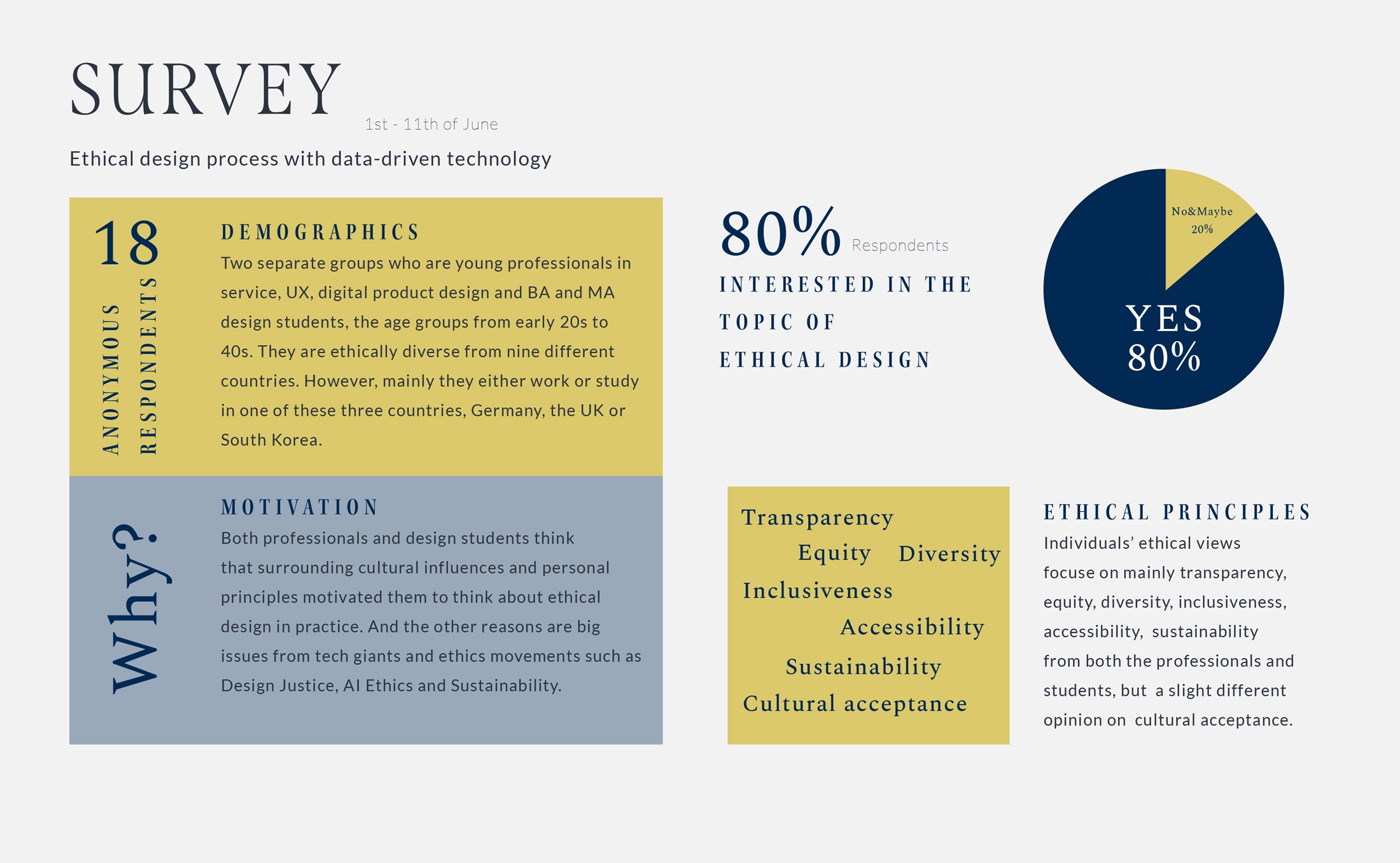
80% of the respondents said that they are interested in the topic of ethical design, and they believe that cultural influences and personal principles surrounding them motivate them to contemplate the significance of ethical design in practice. Other reasons cited included ethical issues with tech giants and movements such as Design Justice, AI Ethics, and Sustainability (climate change).
Their personal principles regarding ethical design with technology primarily revolve around transparency, equity, diversity, inclusiveness, accessibility, and sustainability. An interesting observation is that professionals and students expressed slightly different opinions on cultural acceptance.

Q.Have you faced an ethical dilemma in your design practices and the outcomes?
From the question, have you faced an ethical dilemma in your design practices and the outcomes? 70 % of respondents said yes. Amongst professionals, 40% of responders said that the companies and the professional environment they worked in do not consider any ethical aspects. Because ethical values are not included in KPIs or ROIs that measure the success of the products/services. 40% of people said maybe their companies might consider ethical elements for the products and their businesses.
Diving deep into seeking the 'Whys' at multidimensional degrees, in dilemmas, needs, and pains regarding ethics and design with data-driven technology, I conducted in-depth interviews with nine professionals and six interviews with design students in May and June 2022. The primary purpose of these in-depth interviews was to listen to key actors regarding their experiences and mindsets towards ethical design practices, including their needs, pains, and feelings.
To sum up, from the in-depth interviews with professional designers the key findings demonstrated there was a clear need for better design processes, outcomes and valuable impacts. They highlighted that they need a safe space to talk about what ethical aspects to consider, and what steps to practise and learn.
The second point raised is what ethical impacts they should aim for, how to achieve them and how to measure them. Due to the complex reality, businesses mostly focus on selling and growth. Most of the respondents stated that they measured the success of their practice and the impact it had through objectives and key results(OKR), key performance indicators(KPI), and return on investment(ROI) from the number of profits and growth. From their point of view, the ethical values and aspects are unfeasible to measure and prove the success of businesses. There were crucial points that highlight a missing co-creation step for technology-enabled services. Tight deadlines, budgets, and the different visions and goals within the organisational levels make ensuring ethical practices are maintained too far-fetched to tackle.

As a result of the survey and in-depth interviews, I created an ethical dilemmas mapping that systematically highlights the dilemmas, facts, and their associated needs and pain points. This diagram also illustrates a range of individuals' ethical principles and the underlying ethical dilemmas. The identified ethical dilemmas are directly linked to business strategies and organisational systems. By visually mapping the key findings, it becomes evident that there are conflicts between the ethical aspects of individuals and the organisational and business objectives.
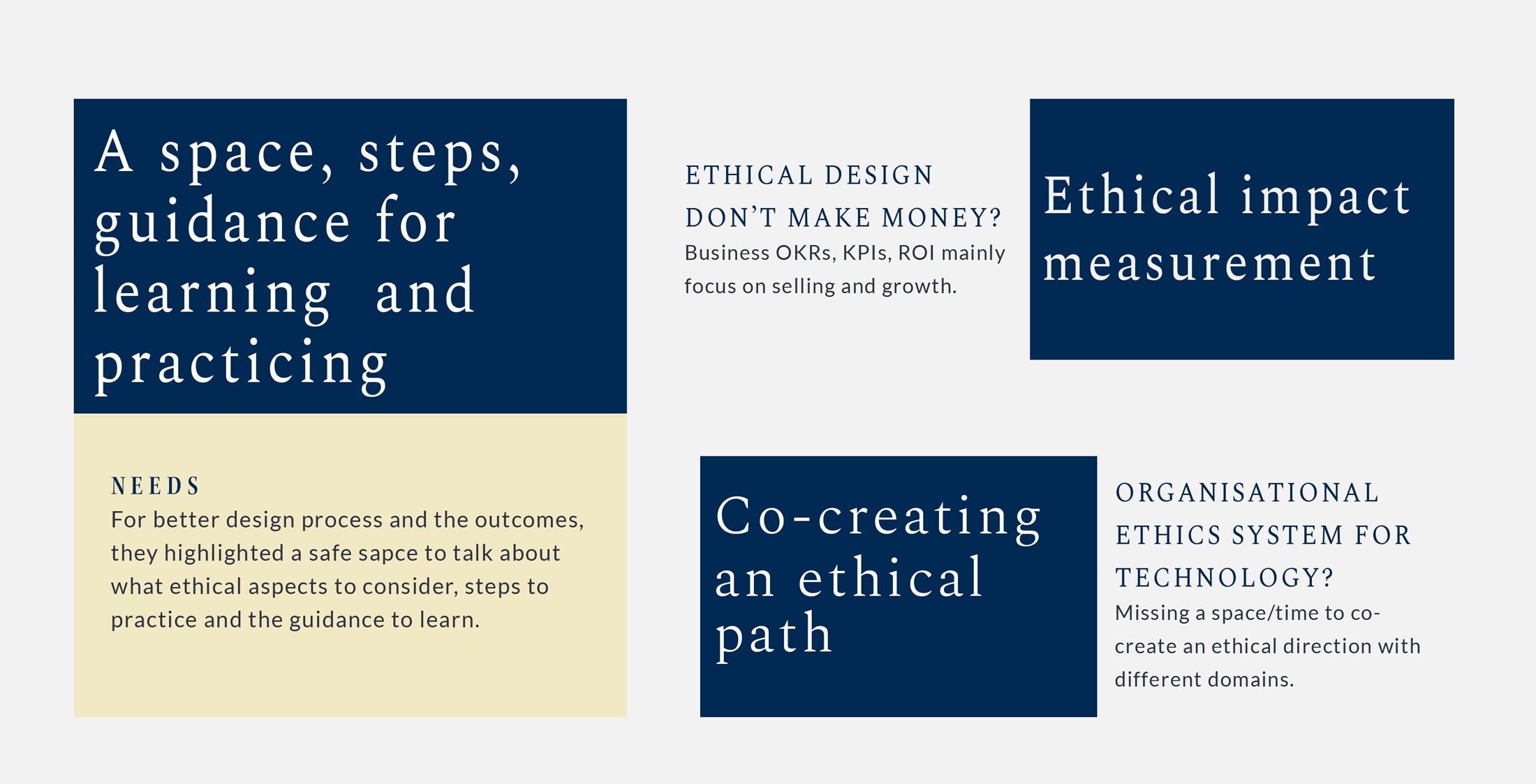
To summarise the key findings from the interviews, there are clear needs for improved design processes, outcomes, and valuable impacts. The participants emphasised the importance of having a safe space to discuss ethical considerations, practical steps to implement ethical practices, and guidance for learning.
The second point pertains to how and what ethical impacts they aim for and how to measure them. Realistically, businesses tend to primarily focus on sales and growth. Many of the respondents stated that they measure success through Objectives and Key Results (OKRs), Key Performance Indicators (KPIs), and Return on Investment (ROI) based on profits and growth. From their perspective, measuring ethical values and aspects for success, especially in business, is challenging and often does not directly contribute to profitability. In addition, there is a missing co-creation step for the ethical purpose of technology-enabled services. Tight deadlines, budgets, and the different visions and goals within the organisational levels are difficult to tackle.
As part of the research methods, I planned and facilitated two participatory workshops at Köln International School of Design, employing the "learning by doing" approach, which is a design research method.
Through conducting two ethical ideation workshops as part of my research, I had the opportunity to observe and learn how design tools and workshop practices, with a focus on ethical elements, can be applied in the design process, particularly during the creation or development phase. Additionally, the workshops aimed to understand the participants' needs regarding ethical principles and their desire to learn, think, and reflect on actions.
The main objectives of these workshops, utilising existing ethical design tools, were as follows:
to explore how an ethical ideation toolkit can be employed as an educational tool within the design ideation process.
to incorporate ethical considerations in the development of service concepts while questioning potential unintended negative impacts in the future.
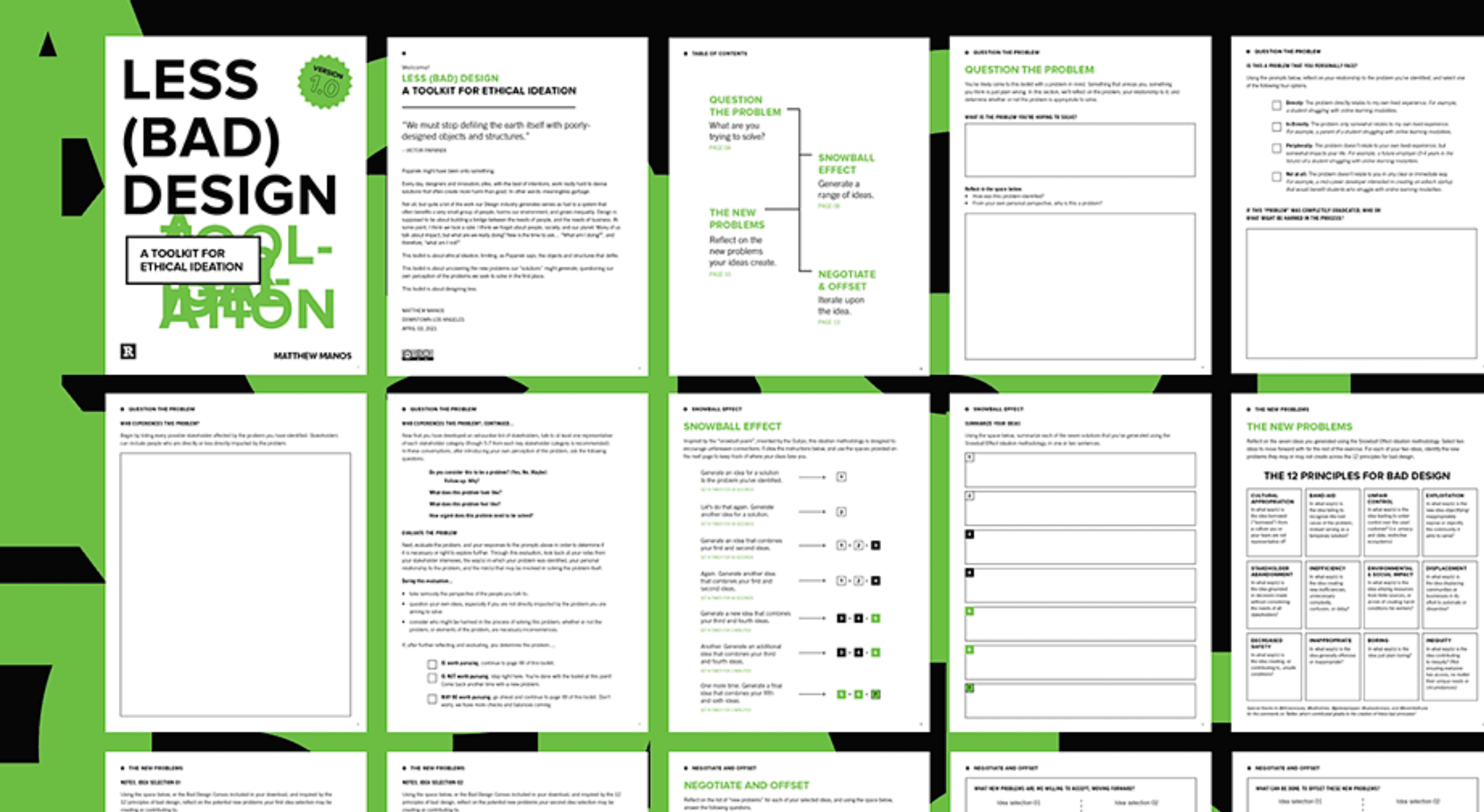
The first workshop, lasting 90 minutes, was conducted online using Zoom and took place with a toolkit called 'Less (Bad) Design - A Toolkit for Ethical Ideation.' This existing toolkit contains twelve principles for identifying potential unintended harms during the ideation phase of design processes. [Link]
Following the initial workshop trial with the toolkit, it became apparent that all participants held different ideas about ethical notions and values. Furthermore, some participants had not previously considered the ethical points to compare and reflect upon.
The second workshop, which lasted 70 minutes, aimed to identify the gap in ethical consideration within a service development project involving KISD design students. Two existing toolkits were used during this workshop:
'The Tarot Cards of Tech,' created by the Artefact Group, is a set of provocations designed to prompt creators to thoroughly consider the impact of technology. [Link]
'Layers of Effect,' created by Katherine M. Zhou, the designer of Design Ethically [Link], consists of three layers: 'primary,' 'secondary,' and 'tertiary' effects. By organising potential harms and related solutions into these layers, participants can gain an understanding of both intended effects and unintended negative consequences.
Those two different tools were combined as a process of ethical consideration. The first step was envisioning potential harmful impacts through twelve critical lenses. After that, the second step was clustering the intended and unintended effects into three layers.
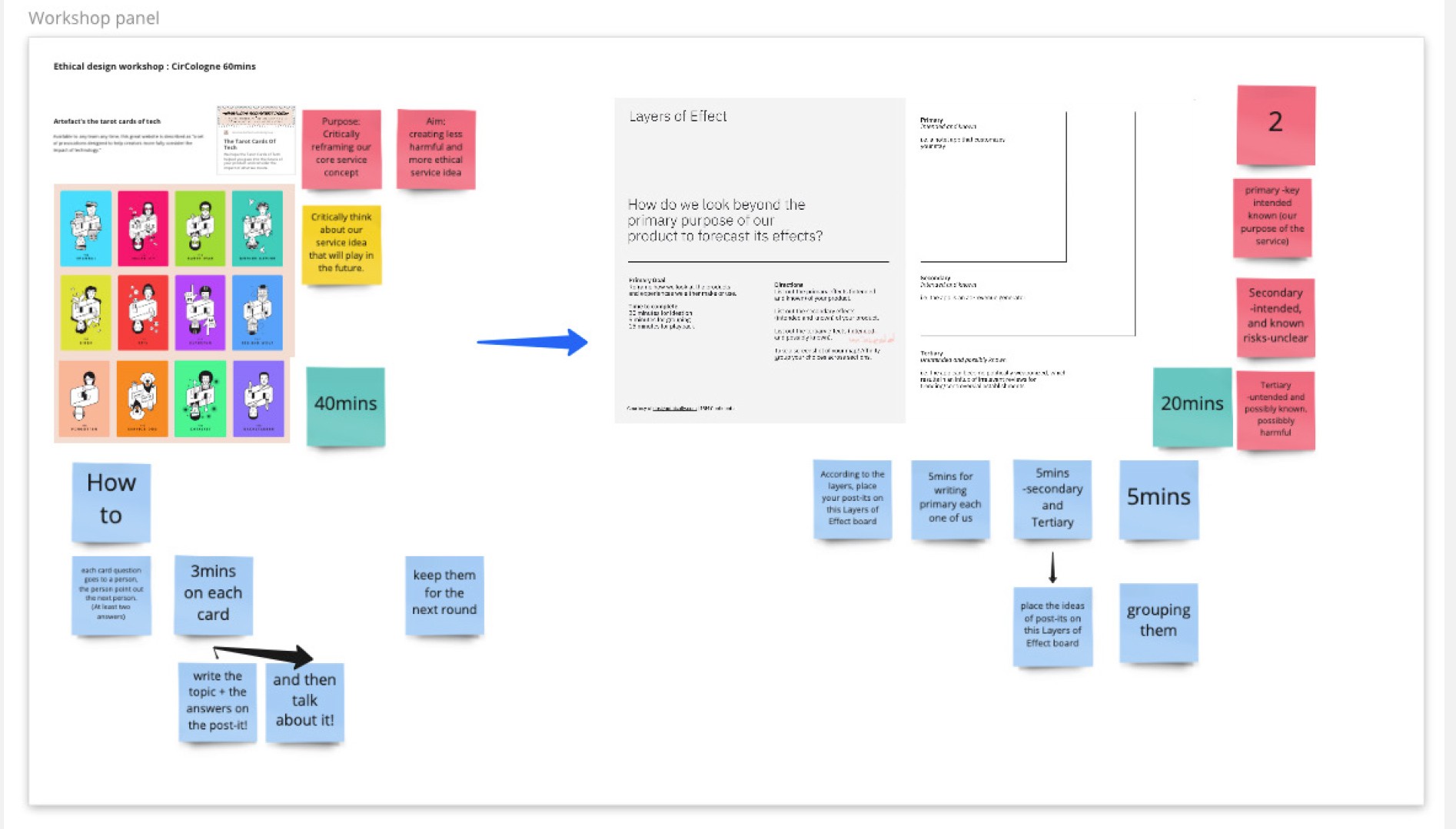

Overall, all participants in the workshops acknowledged the importance of ethical reframing as a practice for idea development, particularly when dealing with technology. They also shared their own ethical perspectives and principles during the reframing ideation exercise. However, there were doubts about the practical implementation of ethical reframing steps in real design practices involving actual businesses.
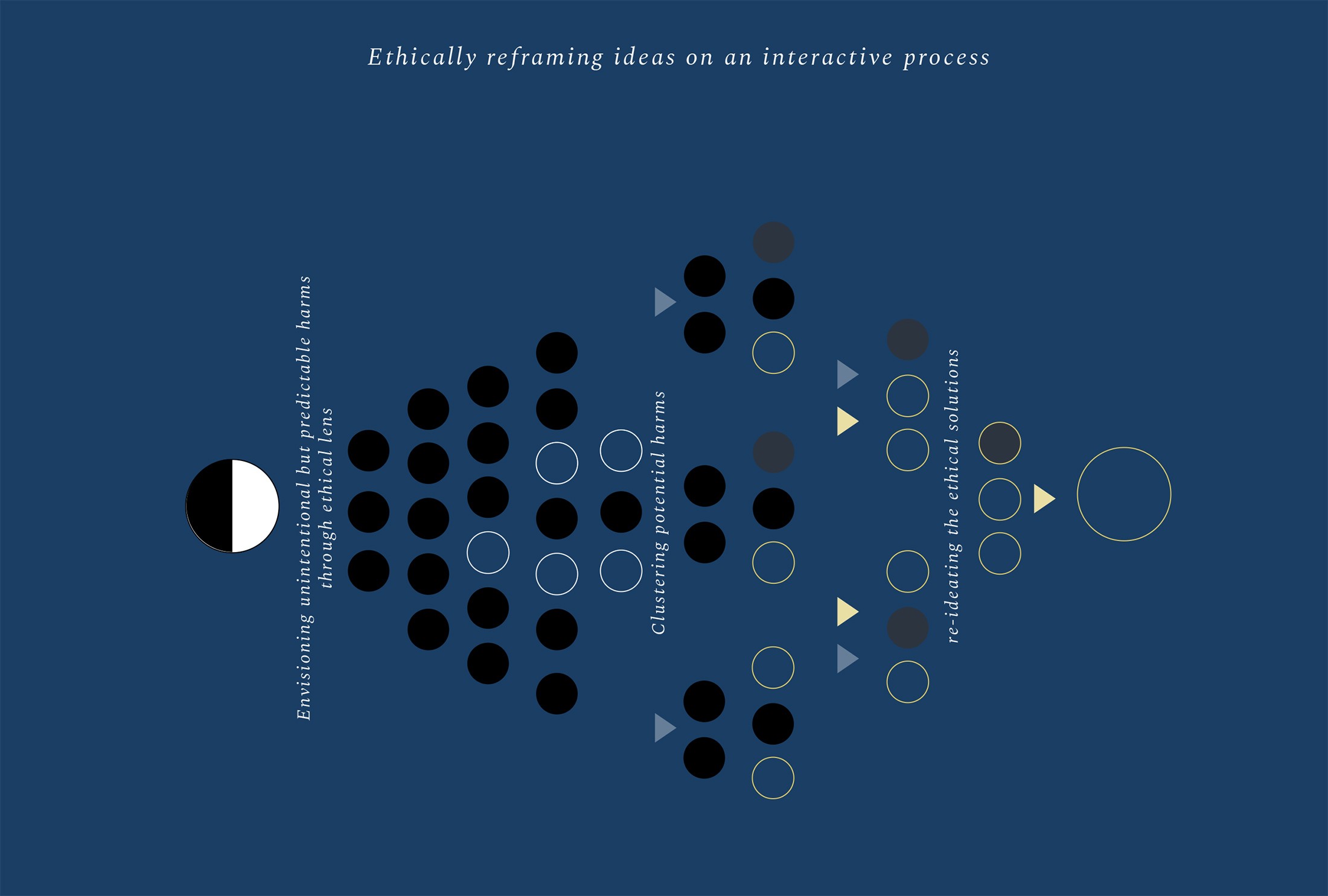
The visual diagram illustrates the reframing process of envisioning potential and unintended harms associated with an idea during the workshop.
In conclusion, after the exploratory research phase, multiple research methods were interplayed, in order to reveal several noteworthy needs and challenges. The majority of interviewees and workshop participants highlighted a lack of ethical consideration, effort, and steps in design processes when creating technology-enabled services. Furthermore, professional designers and design students expressed concerns about a lack of understanding regarding appropriate ethical notions, ethical values, and the specific aspects to consider in their own work. While some had learned and experienced inclusivity, universal design, and sustainability as ethical aspects in their design practices, others had never been exposed to ethical consideration projects or processes during their education or in their workplace. Interestingly, I noticed that there are clear and desirable needs for a space, a process and guidance in learning and practising ethical design.
Furthermore, the designers and design students highlighted that the co-creation of an ethical path with different domains and diverse perspectives in organisational systems was of great importance. On the other hand, there was a doubtful view on the ethics and design practices as some believe that businesses rely and operate solely on measurable performance and profits, regardless of whether or not the technological solution makes a positive impact.
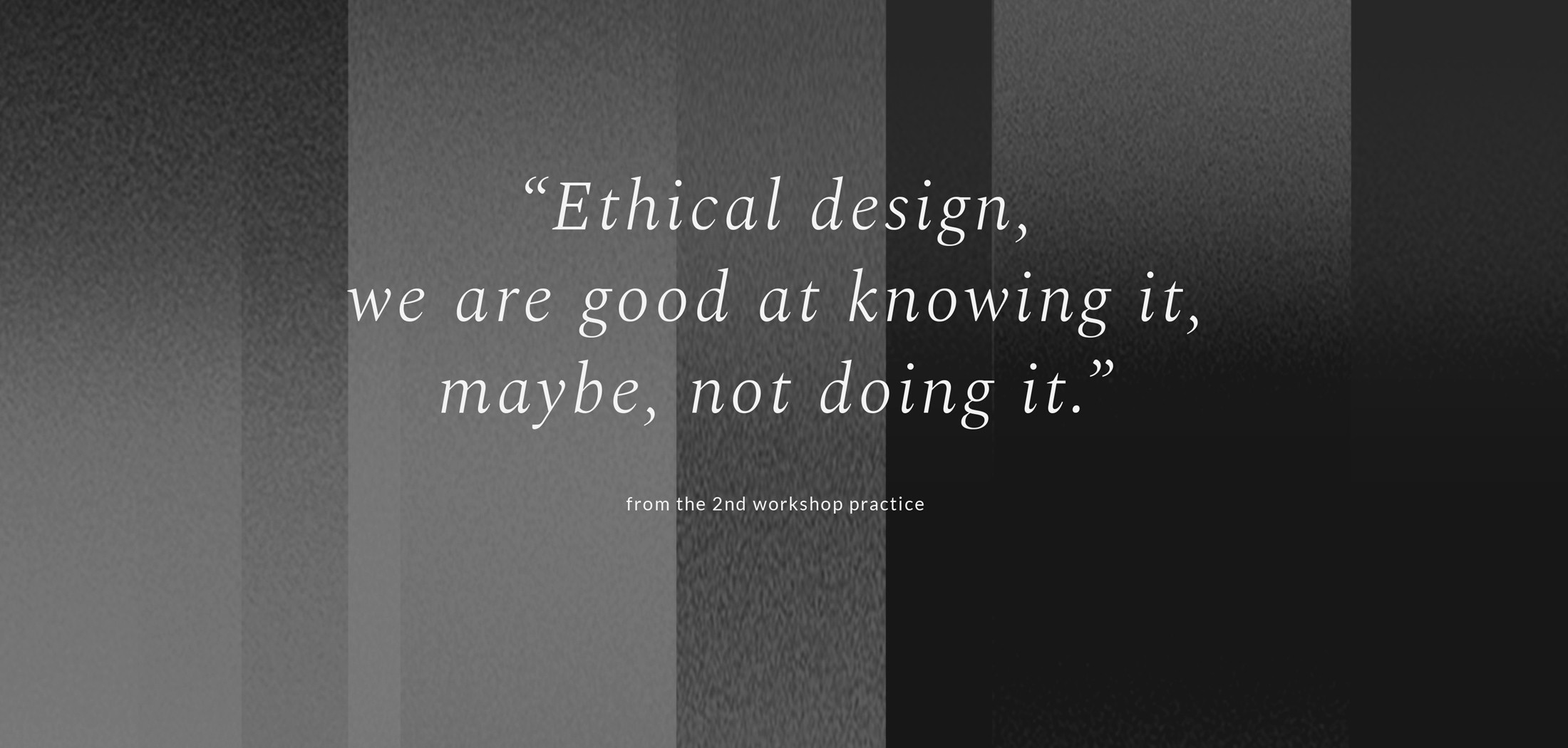
** This article contains a portion of the M.A. thesis research titled "Unpacking the Spectrum of Ethics - Opening a Safe Space and Time for Collaborative Ethical Disclosure" written by Jiye Kim, MA Integrated Design at Köln International School of Design (KISD).
The academic research was supervised by Prof. Birgit Mager (Service Design) and Prof. Dr. Lasse Scherffig (Integration Design) at KISD from March 2022 to January 2023.
About the author:
I am an ordinary person who is not perfect but has a lot of curiosity about "why we design and what we design for" in both theoretical and practical design ethics. I have been fortunate to have opportunities in education and various work experiences as a designer in South Korea and several European countries. The research I conducted was influenced by these previous experiences and focused on exploring the meaning of "ethical" design in creating technological services. These opportunities have allowed me to witness a spectrum of possibilities in ethical design practices, empowering designers to determine not only what we do but also how we do it.
Bibliography:
-Bowles, C. (2020). Future Ethics. 7-33.
-Dilmegani, C. (23, January, 2021). AIMutiple. Top 9 Ethical Dilemmas of AI and How to Navigate Them in 2023. AI Multiple. Retrieved 26 December 2022. https://research.aimultiple.com/ai-ethics/
-Dilmegani, C. (29, August, 2020). AIMutiple. 85+ Digital Transformation Stats from reputable sources. AI Multiple. Retrieved 5 December 2022. https://research.aimultiple.com/digital-transforma- tion-stats/
-Hao, K. (21, October, 2018) MIT Technology Review. ‘Establishing an AI code of ethics will be harder than peo-ple think’, https://www.technologyreview.com/2018/10/21/139647/establishing-an-ai-code-of- ethics-will-be-harder-than-people-think/
-Maeda J. (2019). How to Speak Machine. Computational Thinking for the Rest of Us. 11 -15.
-O’Neil, C. (2016). Weapons of Math Destruction.
